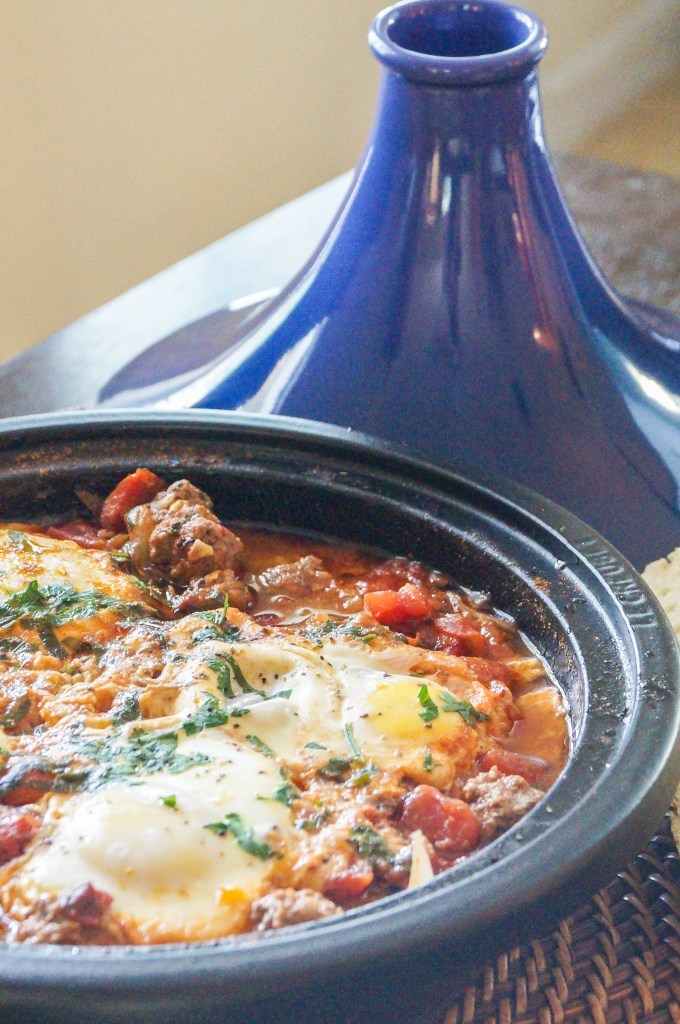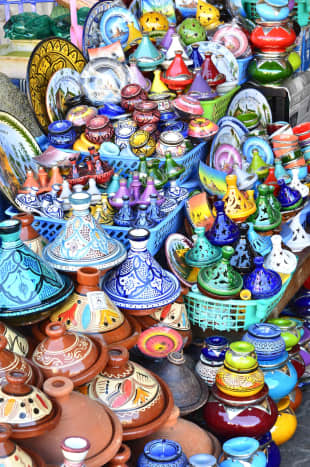Exploring Moroccan Tagine: History, Techniques, and 8 Recipes
Linda explores food facts, folklore, and fabulous recipes, one ingredient at a time.
Morocco: Mosaic of Nationalities, Climate, and Cuisine
There is an exotic land—a confusion of geography, climate, and nationality. Although geographically situated on the African continent, its ties to Islam link it indirectly to the Middle East. But then Europe enters into the scene. At the Strait of Gibraltar, Spain is a mere nine miles away. Kissed by the Mediterranean Sea and the Atlantic Ocean, this is a land of beaches but also a gateway to the Sahara Desert.
This land is Morocco, a beautiful paradise that everyone wanted to claim as their own. There were invaders—century upon century of invaders. From present-day Lebanon came the Phoenicians, followed by the Carthaginians of Tunis. Of course, the Romans entered the scene (146 B.C.) and held fast for more than 200 years. Berbers swept in next, removing the last of Roman authority in 429 A.D. Fast-forward little more than 300 years later and the Arabs descended as well, using their position to launch attacks on Spain. In the 16th and 17th centuries, Spain invaded; pirate raids became commonplace.
Finally, in the 19th century, the power-hungry French moved in. Battles between the French interlopers and Muslim Moroccans continued until 1930 when 300,000 French troops were aided by 100,000 Spanish seeking retaliation. As one might surmise, the Moroccans were completely defeated. And so, Morocco remained a protectorate of France until 1956.
In late 1955, in the Revolution of the King and the People, Sultan Mohammed V successfully negotiated the gradual restoration of Moroccan independence within a framework of French-Moroccan interdependence. The sultan agreed to institute reforms that would transform Morocco into a constitutional monarchy with a democratic form of government. In February 1956, Morocco acquired limited home rule. A French-Moroccan Agreement was signed in Paris on March 2, 1956. —Wikipedia
The Tagines of Morocco
The food of Morocco is complex with the strong influence of all of her past suitors—the cuisines of France, Spain, and the Arab world imbue every dish with the romance of fruits and spices of generation upon generation. The stew known as the tagine, fragrant with heady herbs and spices, rich with meat, fruits, and fresh vegetables certainly fits this description.
Tagine can be prepared with any meat, fish, poultry, or even as a vegetarian dish and it is undoubtedly a meal for all seasons, adaptable to whatever fresh and local ingredients are on hand.



What Do You Need to Make the Perfect Tagine?
The Cooking Vessel
The word tagine is not only the name of the stew but is also the name of the pot in which it is prepared (perhaps a "which came first, the chicken or the egg" scenario). A Moroccan tagine consists of a shallow glazed earthenware bowl to hold all of the ingredients. But instead of a typical lid, a cone-shaped cover is placed on top.
If it's within your budget to purchase one, you can certainly find one online. (Go to the world-famous online store that sells everything on the planet). Otherwise, you can use a Dutch oven or a heavy skillet with a tight-fitting lid.
If you decide to purchase an authentic clay tagine, I would recommend that you opt for a glazed pot. Unglazed pots have a rustic beauty, but require more preparation and seasoning to maintain.
Preserved Lemon
Many tagine recipes will ask you to add preserved lemon to the dish. If you happen to live in a large metropolitan area you might be able to find these in the gourmet section of your grocery store. But, if you can't find them on your local store shelf, you can make your own.
Ingredients
- 5 organic lemons
- 1/4 cup Kosher salt
- Juice of 6 to 8 additional lemons
Instructions
- Quarter the lemons almost all the way through from tip to tip—they should still be attached at one end. Rub salt inside each quartered lemon.
- Pack the lemons in a sterilized quart jar. Add any salt that remains and enough lemon juice to cover.
- Seal the jar and allow it to stand at room temperature in a dark, dry, and cool place for 14 days, inverting the jar every day. After 14 days store the jar in the refrigerator.
- Rinse the lemons before using (use the rind only).
Ras el Hanout
The name means "head of the shop," the best spices one has to offer. Ras el hanout (pronounced "ross el hanOOT") is a spunky, savory blend that varies from region to region, house to house, and even cook to cook. The primary ingredients are coriander, cinnamon, cardamom, and peppercorn. Here is a recipe that uses nine seasonings you probably already have in your pantry. Simply blend them all together and store in a tightly lidded jar in a cool, dry place.
Ingredients
- 1 teaspoon ground cumin
- 1 teaspoon ground ginger
- 1 teaspoon table salt
- 3/4 teaspoon freshly ground black pepper
- 1/2 teaspoon ground cinnamon
- 1/2 teaspoon ground coriander seeds
- 1/2 teaspoon cayenne
- 1/2 teaspoon ground allspice
- 1/4 teaspoon ground cloves
Couscous
Below is a video that gives you the easy recipe and step-by-step how to make perfect, fluffy couscous. Couscous is made of wheat grain. For those who are sensitive to gluten, brown rice would be a perfectly great substitute.
1. Apricot Chicken Tagine
Fresh, healthy ingredients are the cornerstone of tagine cooking, and this apricot chicken stew is a perfect introduction to the concept of using a tagine. A savory combination of herbs and spices is rubbed onto the skin of chicken thighs (or drumsticks). Dark meat is really the better choice for this dish—chicken breasts would turn dry and chalky in the long simmer; chicken hindquarters emerge succulent, moist, and fall-off-the-bone tender. Tomato and lemon provide a tart, savory counter to the sweet note of dried fruits and honey.
2. Lemon Olive Chicken (Djej M’Chernel)
Poultry is the foundation for this savory lemon olive chicken, but it's the tangy lemon and briny olives that are the stars of the show. Green olives are picked at the start of the harvest season and are typically firmer than their black (ripe) counterparts.
If you are fortunate to have a deli nearby that sells olives, look for the picholine, torpedo-shaped olives from France, that are tart and anise-y. If you cannot find those, the Manzanilla, a brine-cured crisp olive from Spain would be a good substitute.
3. Eggplant and Pumpkin Tagine
Do not skimp on the time to low-and-slow caramelize the onions for this eggplant pumpkin tagine. When treated with patience, onions transform from hot and biting to beautifully sweet and soft; they almost melt. With turmeric and ginger, they create a rich and comforting sauce for the creamy vegetables. Serve this over a steaming mound of couscous.
4. Fish Tagine With Preserved Lemon
Cooking fish in a tagine is a guarantee that the fish will always be cooked perfectly—moist, flavorful, and flaky. This recipe from the May 2006 issue of Cooking Light magazine suggests mahimahi. Halibut, sea bass, or tilapia would make excellent substitutions of mahimahi isn't available.
5. Moroccan Beef Tagine
I included this recipe for Moroccan beef tagine because sometimes you want a dish with the amazing flavors of tagine without the lengthy cooking time. Instead of braising cubes of beef, Kevin Lynch used lean ground beef; it's economical and has all the beefy savory flavor of stew meat without the hassle. However, don't assume that this tagine is boring—there are plenty of earthy spices, a pinch of cayenne for heat, tomato for added umami flavor, and just the right balance of sweet and tangy with apricots, raisins, olives, and preserved lemon.
6. Moroccan Seafood Tagine
7. Moroccan Lamb Tagine
This lamb tagine is a beautiful contrast of tastes and textures. There's a sweet edge from the dates and honey and a bit of sour from lemon juice. The softness of the lamb, cooked to perfection, is juxtaposed with the deliciously crunchy almonds. And then, a kick of hot and earthy spices as well.
8. Vegetable Tagine With Almond and Chickpea Couscous
This final recipe is one more gift to my vegetarian friends (and daughter) who adore the sweet/savory blend of fruit and spice that is the tagine but don't want the meat. This vegetable tagine, rich and savory with ground spices and harissa paste, sweet with honey and apricot, and scented with fresh mint, gets a protein boost with the addition of chickpeas (garbanzo beans) to the couscous accompaniment.
© 2021 Linda Lum
Comments
Linda Lum (author) from Washington State, USA on February 02, 2021:
Rachel, and it smells just as wonderful as it looks.
Rachel L Alba from Every Day Cooking and Baking on February 02, 2021:
Moroccan stew looks very interesting. Thanks for sharing your reicpe.
Linda Lum (author) from Washington State, USA on January 26, 2021:
Alexadry I'm glad I was able to introduce you to something new.
Adrienne Farricelli on January 26, 2021:
Thanks for sharing all the mouth-watering recipes from Morocco. I have never heard about tagine before, and now I am curious about trying these dishes.
Linda Lum (author) from Washington State, USA on January 25, 2021:
Flourish, as long as there is breath in this body there will be an article each Monday. Thank you for your kind words and your friendship. Love you.
FlourishAnyway from USA on January 25, 2021:
I’ve never heard of this but enjoyed the history, your superb writing, as well as the comments. Bill had me laughing about the pumpkin version— not his taste I guess. Keep these lovely and adventurous articles coming.
Linda Lum (author) from Washington State, USA on January 25, 2021:
Shauna, I miss you too! This sneaking through the back door is getting too complicated. Unfortunately, my husband does NOT like olives. Yeh, I know that means more for the rest of us, but I can't have him throwing olives at me off of his plate, can I? (LOL).
Shauna L Bowling from Central Florida on January 25, 2021:
These dishes all look so good, Linda! I've never had Tagine, but the first photo makes me want to try it.
Over the weekend, on The Pioneer Woman, Ree Drummond made dishes from around the world. One dish she made was the Moroccan Lemon Olive Tagine. That looks good, too. I love me some olives!
Hope you're doing well, Sis. I miss you!
Linda Lum (author) from Washington State, USA on January 25, 2021:
Denise, I don't think it's really that odd. Pork and fruit is pretty commonplace (at least in my corner of the world--ham and pineapple, pork chops and spiced apples). I'm glad you like the recipes.
Denise McGill from Fresno CA on January 25, 2021:
How interesting to add fruit to a savory dish. I'll have to try the vegetarian version. Thanks for thinking of me (and your daughter).
Blessings,
Denise
Linda Lum (author) from Washington State, USA on January 25, 2021:
Manatita, thank you for your kind words. I hope my words took you there for a few moments. The war of man vs. man probably began with Cain and Abel, right? Yes, and there always will be until the end of time.
manatita44 from london on January 25, 2021:
Beautiful dishes, particularly the last one! Your African stories are amazing. I have a Moroccan friend and you probably know more than she does. Awesome!
So we can agree that there has always been war? Lol. Nothing is new and in the history of evolution bad stuff has always happened. Yet there will be Light. Let us pray!
Linda Lum (author) from Washington State, USA on January 25, 2021:
Thank you Ann for taking the time to stop by and leave your comments (I know it's not always an easy task). I have considered purchasing a tagine for myself--I love the flavors, but I fear that I wouldn't be able to pick it up (mobility issues), so perhaps I'll just go back to this article and look at the photos from Marrakech when the urge strikes.
Ann Carr from SW England on January 25, 2021:
I've had tagine in France, served in an authentic pot by neighbours of ours when we had a house there. It's delicious. I also love couscous so you can't go wrong.
Interesting history here, too, which you do so well, Linda. I also love the varieties and recipes that you've come up with. I like fruit and meat together, though the French always tell us that's not right (pineapple with gammon, apple with pork, etc.) - then they love tagine, so they're mixing their message I think!
Wonderful hub, as always, Linda.
Ann
Linda Lum (author) from Washington State, USA on January 25, 2021:
Good morning Pamela. I'll never visit Morocco, but we can go there in our dreams, can't we? Thank you for your kindness and support. The book has been on the back burner and it's time to move that pot and get started once again. I hope you have a good week, my friend.
Linda Lum (author) from Washington State, USA on January 25, 2021:
Bill, #3 would not be my first (or second) choice either, but I had to include it for my vegetarian friends. This will indeed be a wonderful day. 'Tis my older daughter's birthday.
Thank you for your kind words; they mean a lot to me.
Pamela Oglesby from Sunny Florida on January 25, 2021:
It would be fun to visit there simply to eat their food. I really enjoyed read the history of Morocco. I would like to try seveal of the dishes you listed.
The is another great article, Linda, I hope you cookbook is progressing. Have a wonderful week.
Bill Holland from Olympia, WA on January 25, 2021:
You can toss out #3 as simply inedible, but the other recipes sounds like something I'd try, and that's saying quite a bit. Loved this history of this; loved the cultural information; as always, love anything you write.
Have a chilly, lovely week, my friend.
























